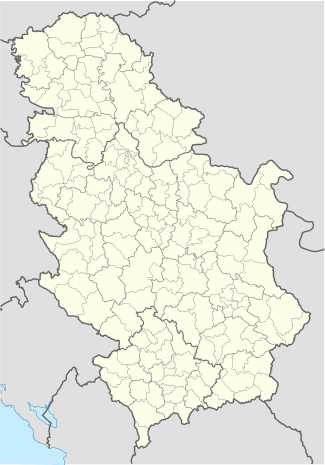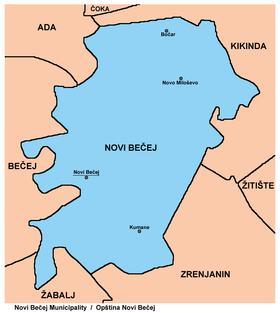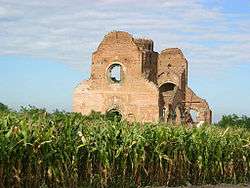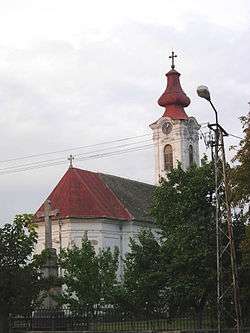Novi Bečej
| Novi Bečej Нови Бечеј | |
|---|---|
| Municipality and Town | |
|
Serbian Orthodox church in Novi Bečej | |
 Novi Bečej Location of Novi Bečej within Serbia | |
| Coordinates: 45°36′N 20°7′E / 45.600°N 20.117°ECoordinates: 45°36′N 20°7′E / 45.600°N 20.117°E | |
| Country | Serbia |
| Province | Vojvodina |
| District | Central Banat |
| Government | |
| • Mayor | Saša Šućurović (LDP) |
| Area | |
| • Novi Bečej | 609.0 km2 (235.13 sq mi) |
| Population (2011) | |
| • Novi Bečej | 13,133 |
| • Metro | 23,925 |
| Demonym(s) | novobečejci, (sr) |
| Time zone | CET (UTC+1) |
| • Summer (DST) | CEST (UTC+2) |
| Postal code | 23272 |
| Area code(s) | +381(0)23 |
| Car plates | ZR |
| Website | www.novibecej.rs |


Novi Bečej (Serbian Cyrillic: Нови Бечеј), is a town and municipality in Central Banat District of Vojvodina, Serbia. The town has a population of 13,133, while Novi Bečej municipality has 23,925 inhabitants.
Name
Novi Bečej means "new Bečej". In the past it was known as "Turski Bečej" (Турски Бечеј, Turkish Bečej), while the current town of Bečej, across the river Tisa (in Bačka region) was in the past known as "Stari Bečej" (Стари Бечеј, "old Bečej") and today is known as "Bečej".
There are several theories about town's name origin. The first one is that it derives from "Castellum de Beche", which was the name of the fort located nearby today's town center. The other theory is that the name was given after the family Wechey, which used rule the settlement and the land around modern-day Novi Bečej. The town was also known as 'Turski Bečej' (Турски Бечеј) and in 1919 it was renamed to 'Novi Bečej' (Нови Бечеј), and for short period of time after the World War II the name of the town was Vološinovo / Волошиново (after red-army's colonel Volosinov who died in the battle for the liberation of the town). The name Novi Bečej was in official use since 1952.
In Serbian, the town is known as Novi Bečej (Нови Бечеј), in Hungarian as Törökbecse and in German as Neu-Betsche. Serbian and Hungarian language are officially used by municipal authorities.
History
12th century BC ornitho-morphic pendants were found in the town. The Dacians inhabited the region before the Roman conquest in the 2nd–1st century BC.
The town was first mentioned in 1091 during the administration of the Kingdom of Hungary. In the 15th century, it was a possession of the Serbian despot Đurađ Branković. During the Ottoman rule (in 1660/6), it was populated by ethnic Serbs. Ottomans managed her as "Beçe" between 1552–1718. Until 1918 its part of the Habsburg Monarchy, after it is part of the Kingdom of Serbs, Croats and Slovenes and subsequent South Slavic states.
Inhabited places
Novi Bečej municipality includes the town of Novi Bečej and the following villages:
Demographics (2011 census)
Ethnic groups in the Novi Bečej municipality
According to the 2011 census, the Novi Bečej municipality has 23,925 inhabitants, including:[1]
- 16,132 Serbs (67.43%)
- 4,319 Hungarians (18.05%)
- 1,295 Romani (5.41%)
- 2,179 Others and undeclared (9.11%)
All settlements in the municipality have an ethnic Serb majority.
Ethnic groups in the Novi Bečej town
The town of Novi Bečej had 13,133 inhabitants, including:[1]
- 7,738 Serbs (58.92%)
- 3,210 Hungarians (24.44%)
- 609 Romani (4.64%)
- Others and undeclared Yugoslavs (12.00%)
Historical population of the town
- 1961: 16,378
- 1971: 16,075
- 1981: 16,091
- 1991: 15,404
- 2002: 14,452
- 2011: 13,133
Economy
There are several factories operating in Novi Bečej, but the leading branch of economic development is tourism. The town is located on the river Tisa, and thus it offers many leisure opportunities.
Main employers are:
- IGK Polet, ceramics industry, member of Nexe group
- PD Vojvodina, agricultural combine, member of MK Commerce group
- Serbia Manifacture, shoes industry
Culture
The state's 4th largest festival is being held in Novi Bečej. Its name is 'Velikogospojinski Dani', and this manifestation is organised in the honor of the town's saint protector. It gathers more than 200,000 visitors from across the state, but also from the whole region. Most popular Serbian, Croatian and Hungarian singers and bands, such as Lepa Brena, Zdravko Čolić, Severina, Tony Cetinski, Crvena Jabuka, Plavi Orkestar, Željko Joksimović, Edda, Omega, etc. already performed here. Also, great historical legacy is a big boost, since there are remainings of medieval monastery Arača and the old fort.
Arača
Arača, is a medieval Romanesque church ruin about 12 km north of Novi Bečej, Serbia. It is the one of the older churches built church in the region during administration of the Kingdom of Hungary. Department for protection and scientific study of Cultural Monuments in Belgrade issued a decision in 1948, in which Romanesque church of Arača is placed under state protection.
It was built around 1230. The church was robbed and devastated in 1280 and reconstructed in 1370 as required by the Queen Elizabeth, and that’s when the Gothic tower that exists today was, probably, built. In the year 1417 it came into possession of Serbian despot Stefan Lazarević. Later it belonged to Serbian despot Đurađ Branković who gave it, as a present, to Pál Birinyi. In the year 1551 Ottomans burned the cathedral down and it was never reconstructed again. In the end of the 18th century it belonged to Sissány family.
Nature
Slano Kopovo
Slano Kopovo is located in the northeast of Novi Bečej and near the river Tisa. It is one of the last preserved salt marshes in Serbia. It features unique Pannonian habitats typified by salty, muddy ponds and lakes or their occasionally dry beds. Slano Kopovo is a priceless centre of salt-marsh habitats which is threatened with complete disappearance.
The significance of Slano Kopovo is manifold. It is one of the most important and unique bird habitats in Serbia. It is of particular value in that species are found nesting here which are typical of the Ponto-Caspian and sea coasts and not of the Pannonian Plain. This is also a unique stopover point for migratory bird species. With the Tisa close by, species which follow the course of this river and its forest belt readily alight on this wide, open water surface. Slano Kopovo is a favourable environment for cranes, ducks, geese and waders as well as Pied Avocet and Kentish Plover. 203 bird species have been recorded at Slano Kopovo, which is 63% of all the known species in Vojvodina.
Notable citizens
- Aleksandar Berić, Serbian war hero in the Kingdom of Yugoslavia
- Josif Marinković, Serbian composer
- Dubravka Nešović, Serbian singer
- Slavko Simić, Serbian actor
- Joca Savić, actor
- Ognjeslav Kostović, inventor
- dr Vladimir Glavaš
- dr Jene Sentklarai
- Draginja Ružić, first Serbian professional actress
- Nikanor, episkop Bački, prelate
Twin cities
See also
- Municipalities of Serbia
- Central Banat District
- List of places in Serbia
- List of cities, towns and villages in Vojvodina
References
- 1 2 "Population by ethnicity – Novi Bečej". Statistical Office of the Republic of Serbia (SORS). Retrieved 28 February 2013.
- Slobodan Ćurčić, Broj stanovnika Vojvodine, Novi Sad, 1996.
Gallery
 The Saint Clare of Assisi Catholic Church.
The Saint Clare of Assisi Catholic Church. Catholic Church and Old Elementary School after restoration 2011.
Catholic Church and Old Elementary School after restoration 2011.
External links
| Wikimedia Commons has media related to Novi Bečej. |



